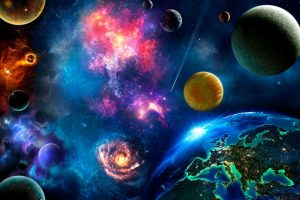Is the universe really expanding? New theory challenges cosmology

 The universe is expanding, or so we think. This is one of the most fundamental assumptions of modern cosmology, based on the observation that distant galaxies are moving away from us with a speed proportional to their distance.
The universe is expanding, or so we think. This is one of the most fundamental assumptions of modern cosmology, based on the observation that distant galaxies are moving away from us with a speed proportional to their distance.
This phenomenon, known as the Hubble law, implies that the universe was smaller and denser in the past, and that it originated from a hot and dense state called the Big Bang, reports space.com.
But what if the expansion of the universe is an illusion? What if there is another way to explain the redshift of light from distant galaxies, without invoking a dynamic and evolving cosmos?
This is the radical idea proposed by Lucas Lombriser, a professor of theoretical physics at the University of Geneva, in a paper published on June 2 in the journal Classical and Quantum Gravity .
Lombriser’s theory challenges the standard model of cosmology, which describes the universe as a flat and homogeneous space-time filled with matter and energy.
The standard model also includes a mysterious component called dark energy, which is responsible for the accelerated expansion of the universe.
Dark energy is usually represented by a cosmological constant, a term that Einstein introduced in his equations of general relativity to allow for a static and stable universe.
However, the cosmological constant poses a serious problem for physicists: its value predicted by quantum theory is vastly different from its value inferred from observations. This discrepancy, known as the cosmological constant problem, is considered one of the biggest puzzles in physics.
Lombriser’s approach to solve this problem is to abandon the assumption of a flat and homogeneous universe, and instead consider a curved and inhomogeneous one.
In this scenario, the universe is not expanding, but rather static and eternal. The apparent expansion is explained by a change in the masses of elementary particles over time, due to their interaction with a scalar field that pervades space-time.
The scalar field acts as a source of curvature for space-time, and its mass determines the value of the cosmological constant.
As the scalar field evolves, so do the masses of particles and the cosmological constant. This leads to a variation in the frequencies of light emitted by atoms in distant galaxies, which mimics the effect of an expanding universe.
Lombriser claims that his theory can explain all the observational evidence that supports the standard model of cosmology, such as the cosmic microwave background radiation, the large-scale structure of galaxies, and the gravitational lensing effect.
He also argues that his theory can account for the nature and origin of dark matter, another elusive component of the universe that only interacts gravitationally.
Lombriser’s theory is not without challenges, however. One of them is to show that his model is stable and consistent with quantum mechanics.
Another one is to test his predictions with new and more precise observations, such as those expected from future missions like Euclid and Vera Rubin Observatory.
Greetings, explorer! We thank our supporters from the bottom of our hearts for their generous donations that keep anomalien.com alive. If you’d like to join the cause and help us continue to deliver amazing articles, please consider making a donation. Let’s keep the 👽 smiling!Follow us on Instagram, Twitter and Telegram for interesting and mysterious bonus content!



